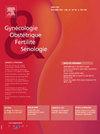Sexualité du couple pendant une grossesse obtenue par assistance médicale à la procréation : une étude comparative
IF 0.6
4区 医学
Q4 OBSTETRICS & GYNECOLOGY
引用次数: 0
Abstract
Objective
To study the sexuality of pregnant women after assisted reproductive technology (ART).
Methods
This was a prospective multicenter study based on two questionnaires: the Female Sexual Function Index (FSFI) and the Couple Satisfaction Index 32 (CSI 32). Two groups were compared: pregnancies following ART and spontaneous pregnancies.
Results
A total of 401 women participated: 215 in the ART group and 186 in the spontaneous pregnancy group. Sexual dysfunction was observed in 49.8% of women in the ART group (n = 108/215) and 44.1% in the spontaneous pregnancy group (n = 82/186). The FSFI score was not significantly lower in the second trimester (24.0 ± 9.3 for ART vs. 25.9 ± 7.3 for spontaneous pregnancy, P = 0.07) but was significantly reduced across all trimesters (23.4 ± 9.2 vs. 25.4 ± 5.8, P = 0.02). Couple relationship quality (CSI 32) was similar between the two groups (134.4 ± 22.2 vs. 133.9 ± 23.9, P = 0.85). Only 13.9% of ART women (n = 30/215) and 8.6% of spontaneous pregnancy women (n = 16/186) had discussed their sexuality during pregnancy with a healthcare professional.
Conclusion
The prevalence of sexual dysfunction during pregnancy is high, particularly among women followed for ART. However, the quality of the couple's relationship remains comparable between the two groups.
[辅助生殖技术后夫妇怀孕期间的性行为:一项比较研究。]
目的:探讨辅助生殖技术(ART)后孕妇的性取向。方法:采用女性性功能指数(FSFI)和夫妻满意度指数32 (CSI 32)两份问卷进行前瞻性多中心研究。两组比较:抗逆转录病毒治疗后妊娠和自然妊娠。结果:共有401名妇女参加,其中ART组215名,自然妊娠组186名。ART组和自然妊娠组分别有49.8% (n=108/215)和44.1% (n=82/186)存在性功能障碍。FSFI评分在妊娠中期没有显著降低(ART组为24.0±9.3,自然妊娠组为25.9±7.3,p=0.07),但在妊娠中期显著降低(23.4±9.2,p= 25.4±5.8,p=0.02)。两组夫妻关系质量(CSI 32)比较,差异无统计学意义(134.4±22.2 vs 133.9±23.9,p=0.85)。只有13.9%的抗逆转录病毒治疗妇女(n=30/215)和8.6%的自然妊娠妇女(n=16/186)在怀孕期间与保健专业人员讨论过她们的性行为。结论:妊娠期性功能障碍的患病率较高,特别是在接受ART治疗的妇女中。然而,夫妻关系的质量在两组之间保持可比性。
本文章由计算机程序翻译,如有差异,请以英文原文为准。
求助全文
约1分钟内获得全文
求助全文
来源期刊

Gynecologie Obstetrique Fertilite & Senologie
Medicine-Obstetrics and Gynecology
CiteScore
1.70
自引率
0.00%
发文量
170
期刊介绍:
Gynécologie Obstétrique Fertilité & Sénologie est un mensuel scientifique d''information et de formation destiné aux gynécologues, aux obstétriciens, aux sénologues et aux biologistes de la reproduction. La revue, dans ses éditoriaux, articles originaux, mises au point, lettres à la rédaction et autres rubriques, donne une information actualisée ayant trait à l''obstétrique et à la gynécologie et aux différentes spécialités développées à partir de ces deux pôles : médecine de la reproduction, médecine maternelle et fœtale, périnatalité, endocrinologie, chirurgie gynécologique, cancérologie pelvienne, sénologie, sexualité, psychosomatique…
 求助内容:
求助内容: 应助结果提醒方式:
应助结果提醒方式:


